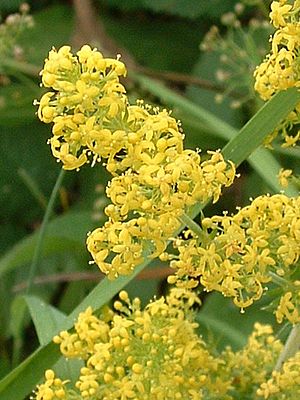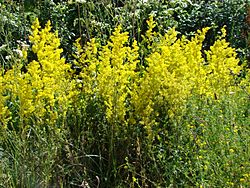Lady's bedstraw facts for kids
Quick facts for kids Lady's bedstraw |
|
|---|---|
 |
|
| Scientific classification | |
| Genus: |
Galium
|
| Species: |
verum
|
Galium verum, also known as lady's bedstraw or yellow bedstraw, is a common plant found in many parts of the world. It is a type of perennial plant, which means it lives for more than two years. This plant belongs to the Rubiaceae family.
You can find lady's bedstraw all over Europe, North Africa, and parts of Asia, from Israel to Japan. It has also spread to places like Tasmania, New Zealand, Canada, and the northern United States. In some areas, it is even considered a weed because it grows so easily.
Lady's bedstraw is a low-growing plant that can spread out quite a bit. Its stems can grow up to 120 centimeters (about 4 feet) long. The plant often roots where its stems touch the ground. Its leaves are small, about 1 to 3 cm long and 2 mm wide. They are shiny, dark green, and have tiny hairs underneath. These leaves grow in groups of 8 to 12 around the stem. The flowers are tiny, only 2 to 3 mm across, and are bright yellow. They grow in thick bunches, making the plant look very pretty.
Contents
Amazing Uses of Lady's Bedstraw
People have used lady's bedstraw for many interesting things throughout history!
Old-Time Uses
- Mattress Stuffing: Long ago, in medieval Europe, people would dry lady's bedstraw plants and use them to stuff mattresses. The plant has a special scent, like vanilla, which helped keep fleas away.
- Cheese Making: The flowers of lady's bedstraw were used to help milk turn into cheese. This is actually how the plant got its name! The Greek word for milk is gala. In a place called Gloucestershire, England, they even used it to give a yellow color to a type of cheese called double Gloucester.
- Natural Dyes: This plant was also used to make natural dyes. You could get a red color, similar to madder, and also a yellow dye from it.
Modern Uses
- Danish Drink: In Denmark, people still use lady's bedstraw to make a special alcoholic drink called bjæsk. They infuse, or soak, the plant in spirits to give the drink its unique flavor.
Lady's Bedstraw in Stories and Legends
This plant has a rich history in many cultures and is part of some fascinating myths and folklore.
Norse Mythology
In Norse mythology, there was a goddess named Frigg. She was known as the goddess who looked after married women and helped them when they gave birth. Because people in Scandinavia used lady's bedstraw to help calm and soothe, they called it Frigg's grass.
Romanian Folklore
In Romanian folklore, lady's bedstraw is called sânziana. It is connected to magical fairies called Sânziene and their special festival, which happens on June 24th.
Gaelic Mythology
The famous hero Cú Chulainn from Gaelic mythology was known for getting very angry during battles. To help calm himself down, he would drink a tea made from this plant. In Scottish Gaelic, the plant is known as lus chneas Chù-Chulainn, which means 'the herb of Cú Chulainn's skin'.
Serbian Folklore
In Serbian folklore, people make special wreaths called Ivanjski venci (which means 'Midsummer wreaths') using Galium verum. They make these wreaths the day before the celebration of Nativity of John the Baptist. These beautiful wreaths, decorated with other flowers, represent the beauty of nature. People hang them on their front gates because they believe the wreaths protect their Christian homes.
Images for kids









